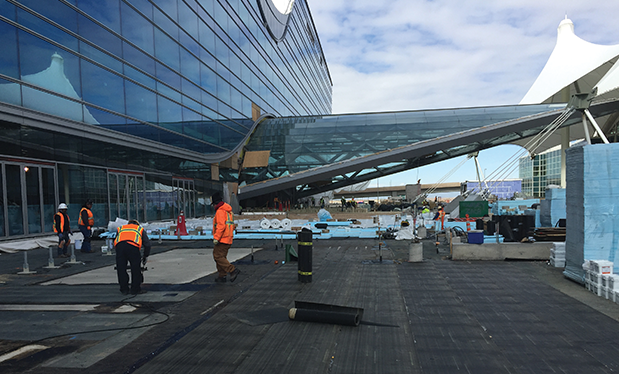Augmented reality headgear may alter the construction industry
Ultra-sophisticated augmented reality (AR) headgear currently being developed and tested eventually may replace traditional hard hats, according to Bloomberg BNA.
The emerging technology is similar to virtual reality (VR), which immerses a user in a simulated world, but AR overlays digital information on a user's view of the real world. An AR headset can be loaded with data from building information modeling (BIM), which creates digital representations of structures. A worker looking at a wall through an AR headset's visor can see displayed BIM-derived imagery of the mechanical and plumbing systems behind the wall. A worker also can use the AR headset's display to check the specifications of a pipe and make sure the pipe is not overheating.
During the past couple of years, multiple AR case studies successfully have demonstrated the technology's cost-cutting, time-shaving and safety-boosting potential, Brian Mullins, CEO of Los Angeles-based AR company DAQRI, told Bloomberg BNA. During the two-year period, several large contractors have taken the technology beyond the pilot phase and started to use AR operationally, Mullins said. He believes the value of AR is similar to mobile computing.
"With a desktop computer, you can do computer-aided design, you can do all your modeling, you get insight. Then, you have to remember that insight when you go out in the field," he says. "With AR, it's like mobile—you're taking it with you and you can have that insight right there, where you can take action."
DAQRI has introduced its Smart Helmet, an industry-focused AR device that includes a high-speed wide-angle tracking camera, a thermal camera, multiple sensors and a sixth-generation Intel Core processor. The device is geared to a variety of industries, including construction. It resembles the top half of a motorcycle helmet and provides head and eye protection.
The broader AR market, for industry and consumers, is projected to reach $80 billion within the decade. DAQRI is one of a few key companies developing AR hardware not geared to consumers, Taylor Cupp, a technologist at Minneapolis-based Mortenson Construction, told Bloomberg BNA. Microsoft Corp., which produced a pair of mixed reality smartglasses called HoloLens, is working with Trimble Inc. to integrate Trimble's 3-D modeling and collaboration software with HoloLens for use in the architecture, engineering, construction and operations industries. And Magic Leap Inc., a startup company, has reportedly been working on a virtual retinal display that projects imagery directly onto the eye.
Mortenson Construction and DAQRI conducted a case study in late 2016 at the building site for a new specialty center of the Hennepin County Medical Center in Minneapolis. According to Cupp, the companies tackled the challenge of taking a planned, coordinated 3-D model and testing the Smart Helmet's ability to project it "in the exact space in the real world of where it was supposed to be located." The case study revealed the technology is "pretty close" to achieving full spatial awareness.
"The devices already do a fair amount of mapping, and they can almost work backward and start to develop a map of the spaces you're in and that you're working on," Mullins says.
According to Cupp, the construction industry in particular has been ripe for innovation. The past year has seen "tons of venture capital" realize the industry historically has lagged in terms of using technology to solve major problems.
AR technology still is developing. According to Cupp, it currently stands where VR technology was a few years ago. Progress has been made getting AR to be as effective in high-activity workplaces with people and moving parts as in static environments, according to Mullins. AR's eventual capability of functioning outdoors at any time and in diverse weather conditions may not be far off.
But for now, AR's current status is similar to the early days of the internet when there were early adopters and skeptics.
"We're in the phase now where a lot of people have actually already realized that, yes, they could save money, yes, they could make workers safer, and if they want to innovate in their industries, now is the time to adopt AR," Mullins says.
San Francisco's local hire goal made permanent
San Francisco's local hire requirement that 30 percent of construction workers hail from the city became permanent under an amendment unanimously approved by the city's board of supervisors March 21. The requirement applies to construction projects on city-owned property and city-owned property sold for housing development.
According to the amendment, the new requirement was designed to ensure the city and its partners "are marshaling limited resources in an effective and coordinated way to create economic opportunities in San Francisco's low-income communities." The amendment also notes the board of supervisors "has not changed its intent with regard to the aspirational goal of a 50 percent requirement and may increase the local hiring requirement through a legislative amendment in response to future market conditions."
San Francisco has had local hire requirements since 1994; local hiring plans are required for projects costing more than $1 million. The provisions don't apply to existing prevailing wage agreements, and contractors must ensure their subcontractors comply. Contractors and subcontractors that fail to satisfy the local hiring requirement must forfeit the prevailing wage for each hour they are short of the target.
Chicago subcontractor convicted of business fraud
A Chicago subcontractor has been sentenced to one year in prison for her role in a multimillion-dollar disadvantaged business enterprise (DBE) scheme, according to The Chicago Tribune.
Elizabeth Perino, owner of Perdel Contracting, Lockport, Ill., was accused of receiving millions of dollars in subcontracts for major public works projects for which she did not perform the work, instead submitting false invoices to Chicago-based road construction company Diamond Coring Co. Diamond Coring was accused of using Perino to meet its DBE hiring requirements. To be certified as a DBE, a firm must be a small business owned and operated by socially and economically disadvantaged individuals, such as women and other minority group members. The Department of Transportation (DOT) requires state and local transportation agencies that receive DOT financial assistance to establish annual goals for the involvement of DBEs.
In June 2016, Perino was convicted of four counts of fraud but claimed Diamond Coring's owner, who was not publicly named, had set her up to win the favor of prosecutors who were investigating him in another fraud case. The owner of Diamond Coring received two years' probation. Perino's attorneys had requested home confinement and probation for their client, but U.S. District Judge Gary Feinerman sentenced Perino to prison to set an example for what he called "an industry that needs to clean up its act."
In 2014, general contractor James McHugh Construction Co. Inc., Chicago, paid $12 million to settle its role in the case but admitted no wrongdoing. The company also agreed to donate $2 million to a Chicago disadvantaged business program and independent monitoring of its subcontracting procedures for three years.
DBE fraud cases are common in the construction industry and usually require a whistleblower before the criminal activity is revealed. In October 2016, five school contractors in New York agreed to pay $825,000 for allegedly using minority firms to submit false documentation they'd provided services as part of the Rochester City School District's school modernization program. A whistleblower alleged the contractors actually purchased their materials and subcontractor services from noncertified firms from 2012-14 but paid the minority firms to assert the materials and services had been purchased from them.
In South Carolina, seven executives from two companies are in legal trouble after they allegedly set up several bogus minority and disadvantaged contractors to help win $350 million in government contracts over several years. Prosecutors claim the group recruited minority firms to help them commit the fraud. The seven individuals face up to 20 years in prison and up to $10 million in fines.
U.S. labor market shows signs of improvement
The U.S. labor market is improving as the U.S. experiences job growth, wage growth and an increase of prime-age laborers, according to Construction Labor Report.
In February, employers added 235,000 positions—more than expected—and measures of joblessness and underemployment also improved. Some of the labor market gains can be attributed to unseasonably warm weather, particularly in construction, but the figures still are solid.
Analysts expect wage gains to gradually accelerate, which likely will lead to increased consumer spending—the principal driver of economic growth—amid a lukewarm first quarter. In addition, the number of workers aged 25 to 54 in the labor force increased to the highest level since 2011.
Construction jobs rose by 58,000, the strongest gain in almost a decade, following an increase of 40,000 jobs in January. Goods-producing industries, which include mining, construction and manufacturing, added 95,000 jobs in February, which is the most since 2000. The latest figures are "consistent with the cyclical upturn in industrial activity around year-end" in the U.S. and other developed economies, says Michael Gapen, chief U.S. economist at Barclays Plc in New York.
Consumer and business optimism for the economy have surged since President Trump's election, and that could result in a "modest boost in hiring," Gapen says. But it will take actual policy changes to drive investment by companies, and such spending has been lackluster during the past year.
ASTM International announces smokin' new committee
Global standards organization ASTM International has announced the launch of a new committee to create technical standards and guidance materials for cannabis and its products and processes. At press time, the committee was pending approval from ASTM International's board of directors.
On Feb. 28, 60 industry representatives and associations met at ASTM International's headquarters to discuss creating a volunteer committee to address cannabis; the committee will be designated D37. The meeting came after ASTM International had received broad interest and inquiries for several years to develop high-quality standards for the cannabis industry. The new committee will focus on developing standards in six technical areas: indoor and outdoor horticulture and agriculture; quality management systems; laboratory; processing and handling; security and transportation; and personnel training, assessment and credentialing. The technical areas also will be subcommittees.
"With its decades of experience in industries such as pharmaceuticals, medical devices, packaging, agriculture, pesticides, and more, ASTM International is the perfect place for standards development for the cannabis industry," says Ralph Paroli, immediate past chairman of the board and director of R&D in measurement science and standards at the National Research Council of Canada. Paroli will serve as the committee's first chairman.
ASTM International's board of directors received a recommendation to approve the committee, and if it is approved, the committee will have its first meeting in the coming months.
Contractor contests fine issued after brother's fatal fall
Kreisel Home Improvement Co. Inc., Amsterdam, N.Y., contested Occupational Safety and Health Administration (OSHA) citations issued after an inspection following the fatal fall of the company president's brother in October 2016. Kreisel Home Improvement is not an NRCA member.
According to Bloomberg BNA, OSHA issued one willful citation and one serious citation Feb. 24 for failure to provide fall protection in residential construction and failure to train employees with recognizing and preventing fall hazards, respectively. OSHA's inspection took place the day after Kreisel Home Improvement President Jeff Kreisel's brother fell 25 feet to his death while working on a house built in 1890. Proposed penalties total $139,424.
Kreisel Home Improvement filed a notice of contest March 8 challenging the OSHA citations. In a March 17 phone interview with Bloomberg BNA, Kreisel denied OSHA's findings and said his brother, David Kreisel, had chosen not to wear a safety harness when he went on the porch roof to remove nails from where the roof attached to the house. David Kreisel fell when the porch roof broke off from the house.
"We have safety meetings all the time, and my brother knew everything about safety," Kreisel says.
Kreisel said having ropes on a roof sometimes can be more dangerous than not having them and few people use them during projects in the local area. He added the OSHA case threatens to put him out of business after 45 years in a company started by his late father.
The OSHA standard for fall protection in home construction requires guardrails, safety nets or personal fall-arrest systems for any work done above 6 feet unless the employer can show an alternative system would be more protective.
OSHA's inspection was part of the agency's national emphasis program on fall hazards and its severe violation enforcement program, which the agency says targets "recalcitrant employers who demonstrate indifference to worker safety and health through willful, repeated or failure-to-abate violations."



